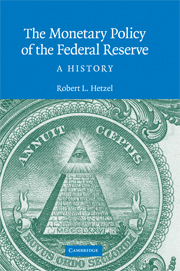Book contents
- Frontmatter
- Contents
- Figures
- Preface
- 1 The Pragmatic Evolution of the Monetary Standard
- 2 Learning and Policy Ambiguity
- 3 From Gold to Fiat Money
- 4 From World War II to the Accord
- 5 Martin and Lean-against-the-Wind
- 6 Inflation Is a Nonmonetary Phenomenon
- 7 The Start of the Great Inflation
- 8 Arthur Burns and Richard Nixon
- 9 Bretton Woods
- 10 Policy in the Ford Administration
- 11 Carter, Burns, and Miller
- 12 The Political Economy of Inflation
- 13 The Volcker Disinflation
- 14 Monetary Policy after the Disinflation
- 15 Greenspan's Move to Price Stability
- 16 International Bailouts and Moral Hazard
- 17 Monetary Policy Becomes Expansionary
- 18 Departing from the Standard Procedures
- 19 Boom and Bust: 1997 to 2001
- 20 Backing Off from Price Stability
- 21 The Volcker–Greenspan Regime
- 22 The Fed: Inflation Fighter or Inflation Creator?
- 23 The Stop–Go Laboratory
- 24 Stop–Go and Interest Rate Inertia
- 25 Monetary Nonneutrality in the Stop–Go Era
- 26 A Century of Monetary Experiments
- Appendix: Data Seen by FOMC for the Stop–Go Period Shown in Figures 24.1, 24.2, and 24.3
- Notes
- Bibliography
- Index
- Titles in the series
10 - Policy in the Ford Administration
Published online by Cambridge University Press: 26 May 2010
- Frontmatter
- Contents
- Figures
- Preface
- 1 The Pragmatic Evolution of the Monetary Standard
- 2 Learning and Policy Ambiguity
- 3 From Gold to Fiat Money
- 4 From World War II to the Accord
- 5 Martin and Lean-against-the-Wind
- 6 Inflation Is a Nonmonetary Phenomenon
- 7 The Start of the Great Inflation
- 8 Arthur Burns and Richard Nixon
- 9 Bretton Woods
- 10 Policy in the Ford Administration
- 11 Carter, Burns, and Miller
- 12 The Political Economy of Inflation
- 13 The Volcker Disinflation
- 14 Monetary Policy after the Disinflation
- 15 Greenspan's Move to Price Stability
- 16 International Bailouts and Moral Hazard
- 17 Monetary Policy Becomes Expansionary
- 18 Departing from the Standard Procedures
- 19 Boom and Bust: 1997 to 2001
- 20 Backing Off from Price Stability
- 21 The Volcker–Greenspan Regime
- 22 The Fed: Inflation Fighter or Inflation Creator?
- 23 The Stop–Go Laboratory
- 24 Stop–Go and Interest Rate Inertia
- 25 Monetary Nonneutrality in the Stop–Go Era
- 26 A Century of Monetary Experiments
- Appendix: Data Seen by FOMC for the Stop–Go Period Shown in Figures 24.1, 24.2, and 24.3
- Notes
- Bibliography
- Index
- Titles in the series
Summary
On August 9, 1974, with the resignation of Richard Nixon, Gerald Ford became president. In the fall congressional elections, voters angered by Watergate elected an overwhelmingly liberal Democratic Congress. Republicans lost 48 seats in the House and 5 in the Senate. With the fall of Vietnam and, especially, Ford's pardon of Nixon, the Ford presidency became highly partisan.
The Republican administration and the Democratic Congress divided over economic policy. Democrats wanted to use government spending to lower the high unemployment created by recession and were tolerant of the then historically high government deficit. The administration, whose chief economist was Alan Greenspan, wanted to limit government spending to lower long-term structural deficits. It wanted to break a perceived link between government deficits, inflation, and boom–bust business cycles.
Administration Economic Policy
At its onset, the Ford administration attempted to reach out to Congress by responding to Senate majority leader Mike Mansfield's (D. MN) resolution requesting a conference on inflation. Addressing Congress just three days after being sworn in, Ford said that “inflation is domestic enemy number 1” (Porter 1980, 10). The administration intended to solicit opinions over how to deal with inflation and how to achieve cooperation between labor and management to defuse a perceived wage–price spiral. Ford presided at the September 27–28 conference, which he termed Whip-Inflation-Now (WIN). At the time, no one predicted the worsening of the recession. Real GDP had fallen in all of the first three quarters of 1974, but only moderately, and bipartisan concern existed over inflation.
- Type
- Chapter
- Information
- The Monetary Policy of the Federal ReserveA History, pp. 108 - 116Publisher: Cambridge University PressPrint publication year: 2008

